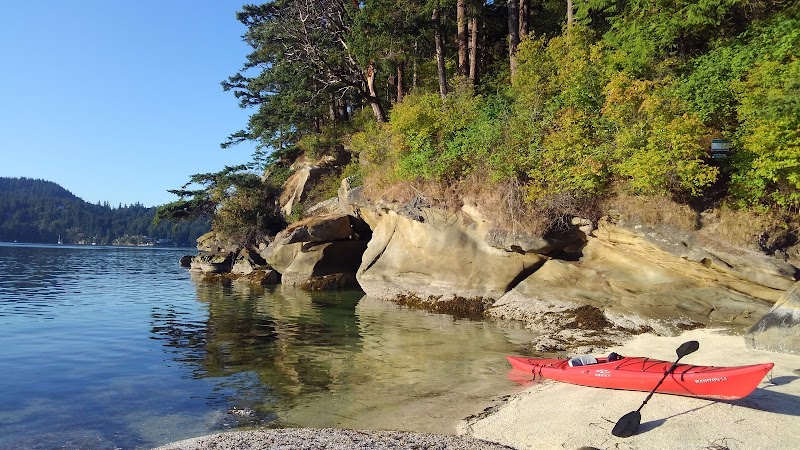
Chuckanut Bay Marine Park Adventures
Chuckanut Bay Marine Park offers stunning coastal vistas and rich marine biodiversity, making it a prime destination for outdoor enthusiasts and nature lovers.
Popular Activities
Capturing the Untamed Beauty of Chuckanut Bay Marine Park: An Adventurer’s Photography Guide
As you lace up your boots and prepare to engage with the stunning landscape of Chuckanut Bay Marine Park, take a moment to consider your camera’s role in this exhilarating journey. This locale in Washington State, where land meets water in a dynamic dance, is a stunning canvas that demands to be captured. Here, along the rugged cliffs and misty coastline, you’ll not only encounter dramatic vistas but also the chance to immortalize a slice of nature’s grandeur through your lens.
Vibrant Shorelines and Coastal Trails
The moment you step onto the trails winding through Chuckanut Bay Marine Park, a world of photographic possibilities unfurls. The 2.5 miles of coastal trails invite you to engage with untamed scenery. As you trek along the verdant paths, take note of the salt-tinged air brushing against your skin and the rhythmic sound of waves crashing onto the rocky shore. The interplay of light and shadow, particularly during the golden hour, transforms the landscape into something almost ethereal, showcasing the vibrant hues of the forest against the deep blues of the bay.
Bring your camera equipped with versatile lenses; a wide-angle will capture sweeping landscapes, while a zoom may spotlight the intricate details of marine flora and fauna. Look for opportunities to photograph the web of trails hugging cliffs and the distant silhouette of the San Juan Islands merging with the horizon. Remember to protect your gear from the elements; a weather-resistant case is essential for those sometimes-drizzly Northwest days.
The Dance of Flora and Fauna
As you navigate deeper into the park, keep an eye out for the symbiotic relationship between the land and its inhabitants. Chuckanut Bay is a haven for wildlife, making it a prime location for wildlife photography. The sounds of chirping birds and rustling leaves accompany your exploration, adding an auditory layer to the visual feast. From inquisitive harbor seals poking their heads above the water to the coastal tide pools teeming with vibrant sea stars, every corner presents an opportunity for stunning captures.
For animal photography, patience is key. Equip yourself with a longer lens to have the flexibility to capture elusive creatures without disturbing their natural behavior. Early mornings or late afternoons provide optimal lighting conditions; the softer light accentuates the colors of the animals, making your images pop.
Framing the Unforgettable Sunset
As the day wanes and the sun begins its descent, prepare for one of the most spectacular displays nature has to offer. Head to a vantage point along the shoreline, where the sky becomes a canvas of orange, pink, and violet streaks that reflect off the water's surface. This moment encapsulates the essence of Chuckanut Bay, providing an unforgettable backdrop for landscape photography.
To capture the sunset in all its glory, use a tripod to stabilize your camera for longer exposures. Experiment with different compositions, perhaps incorporating the textured rocks or silhouettes of trees to add depth to your frame. In post-processing, enhance the colors but aim for authenticity; the magic of this moment lies in its natural beauty.
Practical Tips for Your Adventure
When planning your photography adventure in Chuckanut Bay Marine Park, consider the following:
- Best Time to Visit: The park is accessible year-round, but spring and summer months showcase the most vibrant landscapes.
- What to Wear: Dress in layers and wear sturdy shoes. The terrain can be uneven, so prioritize comfort and stability.
- Hydration and Snacks: Bring plenty of water and light snacks to keep your energy up as you traverse the trails.
- Respect Nature: Stay on designated paths to protect fragile ecosystems, and keep a respectful distance from wildlife.
Embrace the artistic challenge that Chuckanut Bay Marine Park presents. Each photograph you capture will not only document your adventure but also highlight the profound beauty of this remarkable coastal sanctuary. With your camera in tow, you're ready to explore the wild, untamed spirit of Washington, one breathtaking shot at a time.
Plan Your Visit
Everything you need to know to prepare for an unforgettable trip to Chuckanut Bay Marine Park.
Entrance Requirements
No entrance fees; donations appreciated.
Best Time to Visit
Best to visit between April and September for optimal weather.
Visitor Information
No formal visitor center; information available at nearby Bellingham.
Getting There
Accessible via Chuckanut Drive (SR 11), watch for seasonal weather impacts.
Weather & Climate
Mild coastal climate with damp winters and cool, humid summers. Average summer temperatures range from 60°F to 70°F.
Conservation Efforts
Threats include pollution from nearby urban areas and erosion. Conservation efforts focus on marine protection and habitat restoration.
Camping in Chuckanut Bay Marine Park
Find the perfect spot to stay overnight and immerse yourself in the details.
Top Trails
Chuckanut Bay Trail
Offers fantastic views of the bay and access to tide pools.
Intertidal Trail
A short trail that grants direct access to rich marine life viewing areas.
Trailblazer Tips
Visit during low tide to explore vibrant tide pools.
Spring and early summer provide the best weather for outdoor activities.
Parking can be limited on weekends, so arrive early.
Don't forget your binoculars for bird watching opportunities.
